PCB Disposal Practices: Safe & Compliant Waste Management
- Last Updated: June 12th, 2025

Attorney Jessie Paluch, founder of TruLaw, has over 25 years of experience as a personal injury and mass tort attorney, and previously worked as an international tax attorney at Deloitte. Jessie collaborates with attorneys nationwide — enabling her to share reliable, up-to-date legal information with our readers.
Legally Reviewed
This article has been written and reviewed for legal accuracy and clarity by the team of writers and legal experts at TruLawsuit Info and is as accurate as possible. This content should not be taken as legal advice from an attorney. If you would like to learn more about our owner and experienced injury lawyer, Jessie Paluch, you can do so here.
Fact-Checked
TruLawsuit Info does everything possible to make sure the information in this article is up to date and accurate. If you need specific legal advice about your case, contact our team by using the chat on the bottom of this page. This article should not be taken as advice from an attorney.
Key Takeaways:
- Proper PCB waste management involves clear identification, transportation to designated disposal facilities, and high-efficiency disposal methods like incineration and chemical dechlorination.
- Landfills for PCB solid waste must adhere to strict design criteria and monitoring protocols to protect the environment and public health.
- Safety protocols, including training, personal protective equipment, and engineering controls, are crucial for personnel handling PCB waste to minimize the risk of injury and exposure.
Overview of PCB Disposal
On this page, we’ll discuss the proper methods for PCB disposal, regulations governing PCB waste management, the importance of safe PCB disposal in protecting human health and the environment, and much more.
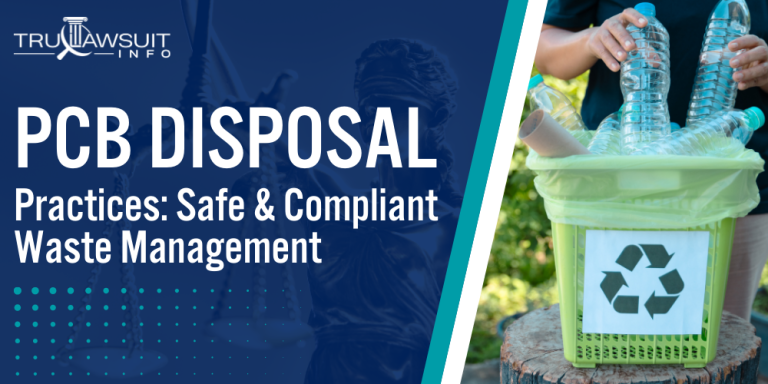
Intro to PCB Disposal
Key aspects of PCB disposal include, but are not limited to:
- Regulatory Requirements: PCB disposal is regulated by the EPA under the Toxic Substances Control Act (TSCA), which sets standards for the handling, storing, and disposing of PCB waste.
- Disposal Methods: Approved PCB disposal methods include high-temperature incineration, chemical dechlorination, and landfilling in specially designed hazardous waste facilities.
- Waste Characterization: PCB waste must be properly characterized before disposal to determine the appropriate disposal method based on the type and concentration of PCBs present.
- Transportation and Manifesting: PCB waste must be transported by licensed hazardous waste haulers and accompanied by proper manifests to ensure safe and compliant handling.
If you or a loved one has been exposed to PCB waste, you may qualify to pursue compensation for your damages.
Contact TruLawsuit Info today using the chat on this page to determine your eligibility to file a PCB lawsuit.
Table of Contents
Classifying PCB Wastes: Liquid, Solid, and Multi-Phasic
Effective PCB waste management is pivotal for environmental health and regulatory compliance.
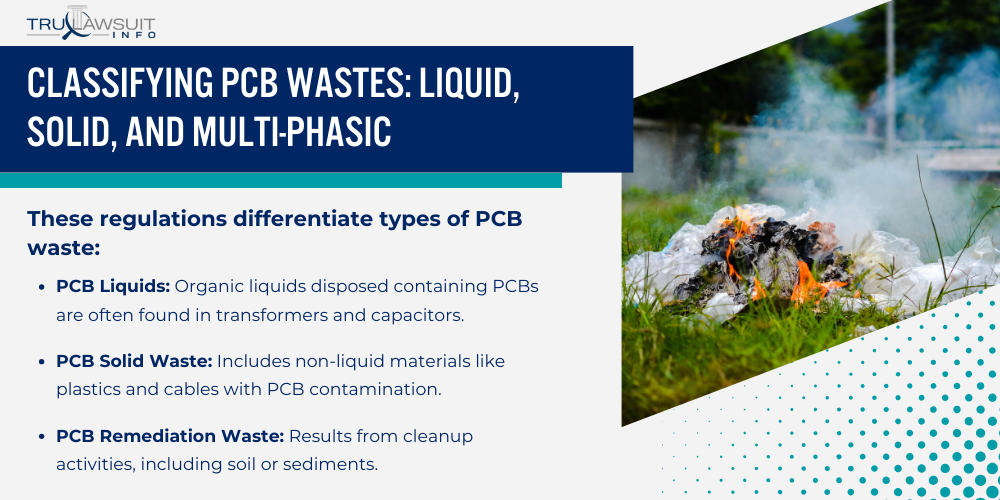
Depending on whether PCB waste is liquid, solid, or multi-phasic, distinct disposal protocols must be adhered to.
Importance of Compliant Waste Management for PCB Safety
Safeguarding human health and the environment mandates strict observance of disposal regulations set forth by the Environmental Protection Agency (EPA).
These regulations differentiate types of PCB waste:
- PCB Liquids: Organic liquids disposed containing PCBs are often found in transformers and capacitors.
- PCB Solid Waste: Includes non-liquid materials like plastics and cables with PCB contamination.
- PCB Remediation Waste: Results from cleanup activities, including soil or sediments.
- PCB Bulk Product Waste: Goods made with PCBs, including caulk and paints.
The risk-based approval process standardizes safe disposal while minimizing potential hazards in managing PCB waste.
Identifying and Inventorying PCB Waste Materials
Accurate identification of PCB wastes is critical to determine the appropriate disposal procedure.
Several categories can be outlined:
- PCB-Contaminated Electrical Equipment: Transformers and other equipment that once contained PCBs.
- Waste Stream Assessment: Identifying the nature and extent of PCB contamination within a waste stream.
- Type of PCB Material: Determination of whether the waste is a product or remediation waste.
- Concentration of PCBs: Measuring the PCB concentration aids in classifying the waste correctly.
Labeling and Recordkeeping Requirements for PCB Disposal
The EPA requires meticulous labeling and recordkeeping for any PCB waste disposed of.
These steps are essential:
- Clear Labeling: Every item of PCB waste must be marked with proper identifiers.
- Documentation: Maintain comprehensive records outlining the disposal process for each type of PCB waste.
- Adherence to Guidelines: Labels should follow the EPA’s specifications for PCB wastes.
- Date and Place: Record the date of disposal and the approved facility where the waste was processed.
Proper documentation ensures traceability and accountability in managing PCB disposal, aligning with Resource Conservation and Recovery Act requirements.
Approved Methods for Treating and Destroying PCB Wastes
Regulatory compliance and environmental safety are paramount when treating or destroying Polychlorinated Biphenyls (PCBs).
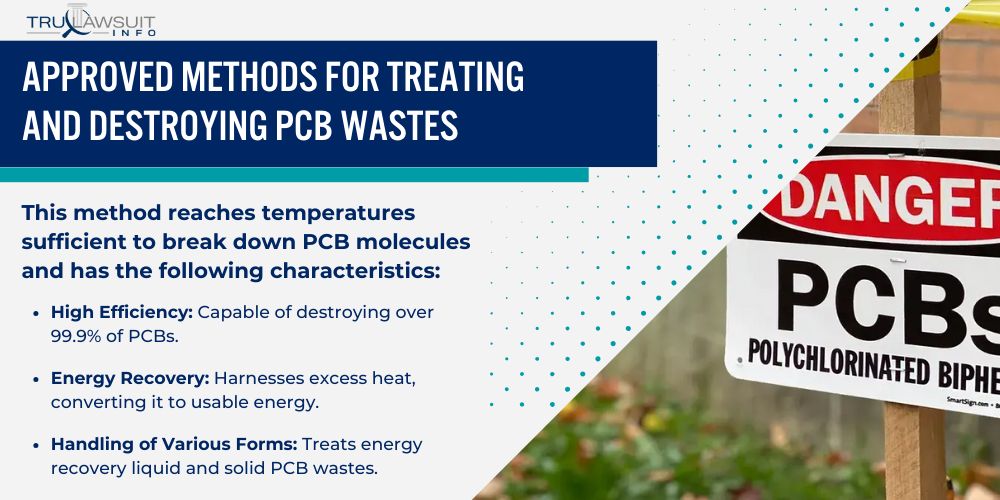
The methods discussed here are part of rigorous procedures and disposal technologies ensuring that these chemical substances have minimal impact.
High-Temperature Incineration of PCB Liquids and Solids
High-temperature incineration stands as the primary method for adequately incinerating PCB waste.
This method reaches temperatures sufficient to break down PCB molecules and has the following characteristics:
- High Efficiency: Capable of destroying over 99.9% of PCBs.
- Energy Recovery: Harnesses excess heat, converting it to usable energy.
- Handling of Various Forms: Treats energy recovery liquid and solid PCB wastes.
- Emissions Control: Equipped with systems to clean exhaust gases.
PCB liquids and contaminated solids can be transported to these facilities, ensuring that the adequate incineration capability aligns with safely treating and analyzing organic liquids collected from various sources, including metal surfaces that may have been exposed to PCBs.
Chemical Dechlorination Techniques for PCB Disposal
Chemical dechlorination represents an alternative disposal technology that neutralizes PCBs by removing the chlorine atoms.
Here’s how it plays a vital part in PCB waste management:
- Versatility: Effective for dechlorinating both liquids and solids.
- Chemical Conversion: Transforms hazardous PCBs into less harmful chemicals.
- Pre-treatment: Often used before incineration to reduce toxicity levels.
- On-site Capability: Can be deployed at the site of PCB contamination.
This technique involves precise processes that add other chemical substances to PCBs, effectively breaking down the molecules and facilitating their disposal while protecting the environment from potential PCB exposure.
Landfilling PCB Solid Wastes: Siting and Design Criteria
When disposing of PCB waste, selecting the right landfill and ensuring it adheres to strict site and design criteria to protect the environment and public health is essential.
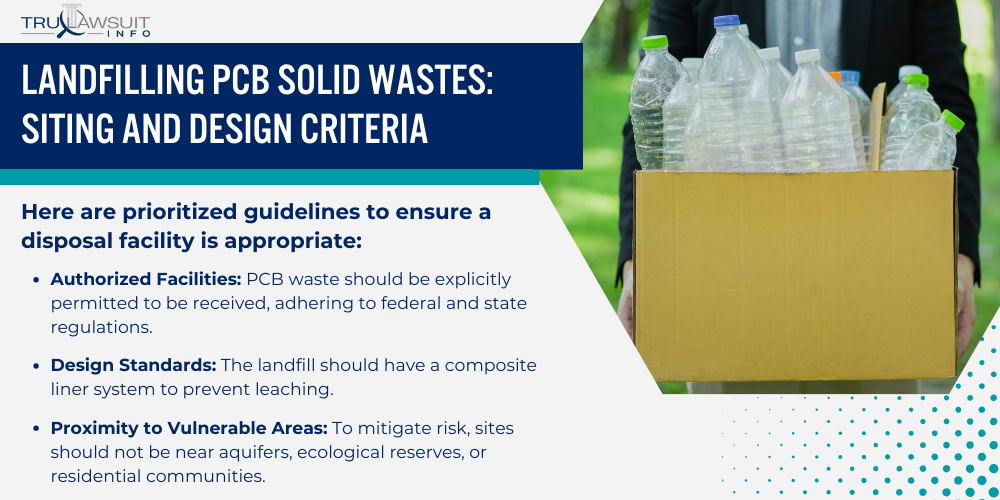
Selecting Appropriate Landfills for PCB Waste Disposal
Polychlorinated Biphenyls (PCBs) require careful disposal; not all solid waste landfills can accommodate these materials.
Here are prioritized guidelines to ensure a disposal facility is appropriate:
- Authorized Facilities: PCB waste should be explicitly permitted to be received, adhering to federal and state regulations.
- Design Standards: The landfill should have a composite liner system to prevent leaching.
- Proximity to Vulnerable Areas: To mitigate risk, sites should not be near aquifers, ecological reserves, or residential communities.
- Capacity and Longevity: Facilities must handle the waste volume and maintain integrity over time to accommodate mineral oil dielectric fluid-tainted equipment.
Monitoring and Maintaining PCB Landfills for Compliance
PCB landfills require strict monitoring and maintenance protocols to safeguard public health and the environment.
These protocols ensure the ongoing containment of PCBs and prevent potential environmental contamination.
The ongoing protocols for PCB landfills are:
- Daily Cover Requirements: Employ a daily landfill cover to minimize the potential release of contaminants.
- Inspection Procedures: Regular inspections by a local environmental protection agency ensure compliance with safety standards.
- Maintenance Practices: Continuous upkeep of the liner systems and leachate collection is vital.
- Documentation and Record Keeping: Landfills must keep thorough records of all PCB waste transactions and handling processes.
Safe Handling Practices for PCB Waste Management Personnel
Proper safety protocols are essential for personnel managing PCB waste to minimize the risk of injury.
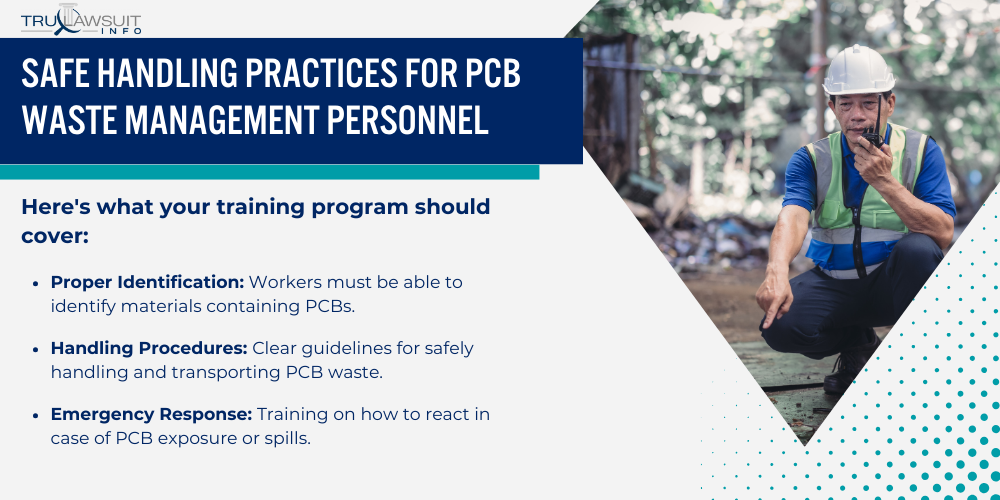
Strict adherence to regulations and appropriate personal protective equipment (PPE) is paramount for those handling Polychlorinated Biphenyls (PCBs), especially when dealing with high PCB concentration or machinery such as PCB hydraulic machines.
Training Workers on Proper PCB Waste Management Protocols
Training is essential to ensure that waste management personnel understand how to handle PCBs safely.
Workers should be aware of the potential risks PCBs pose and the procedures for the safe disposal of waste, particularly when working with mineral oil dielectric fluid that may contain PCBs or at PCB storage facilities.
Here’s what your training program should cover:
- Proper Identification: Workers must be able to identify materials containing PCBs.
- Handling Procedures: Clear guidelines for safely handling and transporting PCB waste.
- Emergency Response: Training on how to react in case of PCB exposure or spills.
- Regulatory Compliance: Understanding local, state, and federal regulations, including 40 CFR part 761, concerning PCB handling and disposal (Managing Remediation Waste from Polychlorinated Biphenyls (PCBs)).
Using Correct PPE and Engineering Controls for PCB Safety
PPE and engineering controls are critical to protect workers from PCB exposure.
It’s important to use protective gear suited for the potential exposure level and implement engineering solutions that limit PCB contact.
To minimize PCB exposure risks, your training program should cover the following measures utilizing PPE and engineering controls:
- Appropriate PPE: Use gloves, goggles, and clothing rated for PCB exposure.
- Exposure Limitation Tools: Using fume hoods and local exhaust ventilation where PCB fumes are present.
- Regular Equipment Checks: Ensuring PPE is contamination-free and that engineering controls are proper.
- Decontamination Processes: Setting up strict procedures for workers and equipment leaving PCB-contaminated areas.
Transportation and Tracking of PCB Wastes for Disposal
In environmental management, the safe transportation and meticulous tracking of PCB (Polychlorinated Biphenyl) waste are pivotal.
![]()
Procedures and regulations ensure this hazardous waste reaches designated disposal facilities without threatening public health or the environment.
Packaging and Labeling Standards for PCB Waste Shipping
Packaging standards for PCB waste are stringent to prevent leaks and spills during transport.
Here are the essentials:
- Containers must be sturdy, sealed, and leak-proof to handle specific waste characteristics.
- In case of a breach, the waste should be surrounded by absorbent materials that can contain twice the volume of the PCBs.
- Adequate cushioning must be provided to minimize movement within the containers.
- All PCB containers must be labeled with the correct PCB waste codes and handling instructions.
Labeling is another critical aspect that aids in the correct handling and tracking of PCB waste:
- Each container must display a clear label stating “PCB Waste.”
- The label should have the date of collection and a unique identifier for traceability.
- Regulatory guidelines must include proper hazard symbols to inform handlers of potential risks.
- Containers require labels indicating the concentration of PCBs they contain.
Manifest Systems for Documenting PCB Waste Transfers
To ensure proper tracking and accountability, manifest systems are crucial in documenting PCB waste transfers.
Manifest systems play a key role in the tracking process of PCB waste disposal:
- Every transfer of PCB waste requires a detailed manifest that records the journey from origin to final disposal.
- The document serves as a written notice for all parties handling and transporting PCB waste.
- This manifest must be signed by the generator, transporter, and recipient to validate each transfer phase.
- Retaining copies of the manifest ensures accountability at each point and aids regulatory compliance.
Preventing Releases and Spills During PCB Waste Management
Effective management of PCB waste is essential to prevent harmful environmental contamination.
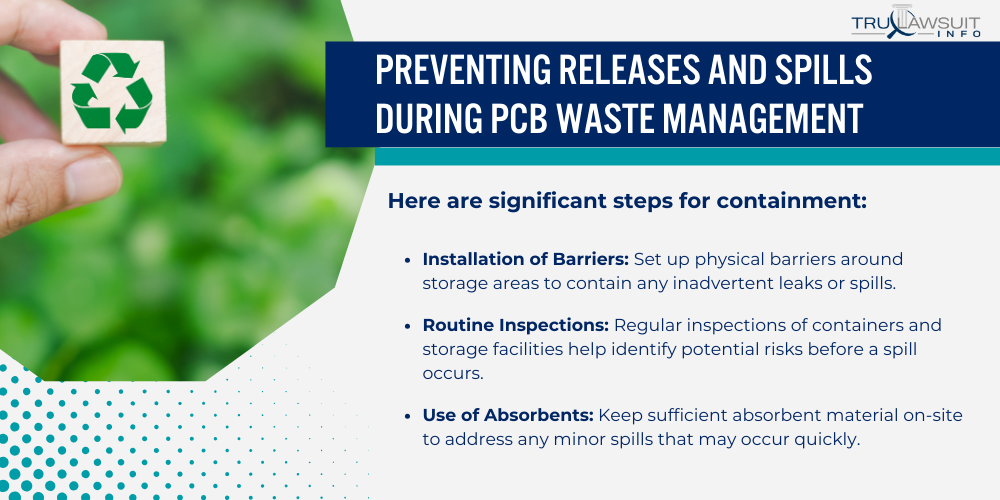
Ensuring PCB waste does not leak or spill during handling is paramount to ecological safety and regulatory compliance.
Implementing Spill Prevention and Containment Measures
Strict spill prevention protocols are necessary to minimize the risk of PCB releases.
Here are significant steps for containment:
- Installation of Barriers: Set up physical barriers around storage areas to contain any inadvertent leaks or spills.
- Routine Inspections: Regular inspections of containers and storage facilities help identify potential risks before a spill occurs.
- Use of Absorbents: Keep sufficient absorbent material on-site to address any minor spills that may occur quickly.
- Secondary Containment: If the primary container fails, employ secondary containment systems, such as double-walled tanks or containment berms, to catch PCBs.
Emergency Response Plans for Accidental PCB Discharges
A well-prepared emergency response plan is critical for promptly addressing PCB discharges.
Key components of an effective plan include:
- Immediate Action Procedures: Outline steps to quickly stop the source of the spill and contain the discharge.
- Notification Protocols: Establish clear methods for alerting the Office of Resource, Land, and Emergency Management Director and other relevant authorities.
- Decontamination Procedures: Include detailed guidelines for cleaning spill sites, emphasizing performance-based disposal methods.
- Training Programs: Conduct regular training and drills for personnel to ensure readiness in an emergency.
Regulatory Oversight and Enforcement of PCB Waste Disposal
Environmental agencies tightly regulate the disposal of Polychlorinated Biphenyls (PCBs) to mitigate the risk to human health and the environment.
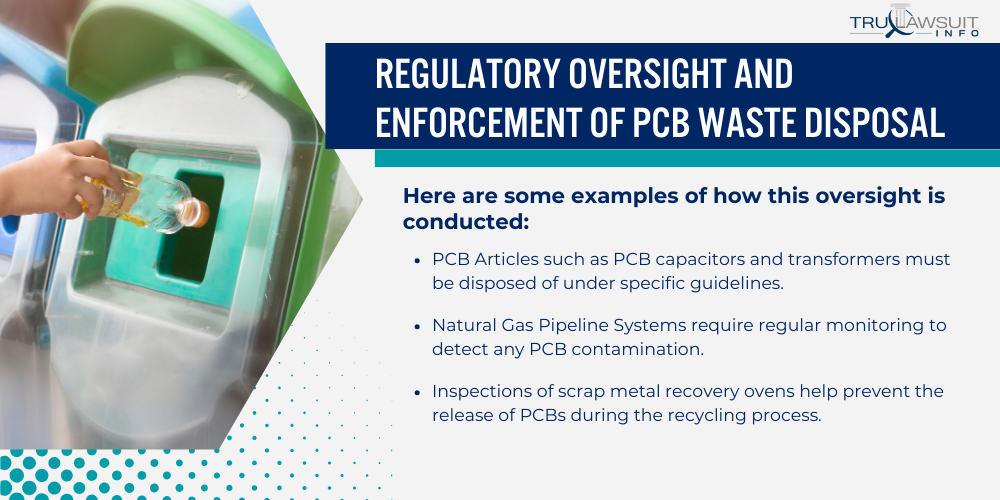
Compliance with the rules set forth for the handling and disposal of PCB waste is mandatory.
Inspections and Audits by Environmental Agencies
Environmental agencies conduct regular inspections and audits to ensure PCB waste generators and disposal facilities comply with federal regulations.
Here are some examples of how this oversight is conducted:
- PCB Articles such as PCB capacitors and transformers must be disposed of under specific guidelines.
- Natural Gas Pipeline Systems require regular monitoring to detect any PCB contamination.
- Inspections of scrap metal recovery ovens help prevent the release of PCBs during the recycling process.
- Disposal Facilities are audited for proper PCB waste handling and decontamination solvent flushing procedures.
Penalties & Liabilities for Non-Compliant PCB Waste Handling
The failure to comply with PCB disposal regulations can lead to severe penalties and liabilities.
Be aware of the following consequences for non-compliant PCB waste handling:
- Hefty fines are imposed on entities that improperly dispose of PCB waste or fail to maintain appropriate records.
- Failure to properly handle PCB equipment during disposal can attract legal action and financial penalties.
- Entities are held liable for any environmental damage from non-compliant PCB waste disposal.
- There may be civil and criminal repercussions for those who intentionally violate PCB disposal laws.
Frequently Asked Questions
-
What are the approved methods for disposing of PCBs?
Approved methods for PCB disposal include, but are not limited to: high-efficiency incineration, chemical dechlorination, and landfilling specifically designed for hazardous waste.
To prevent contamination, these processes must meet and comply with environmental standards.
-
Where can I find authorized PCB disposal facilities?
Authorized PCB disposal facilities can be located through the Environmental Protection Agency (EPA) regional offices.
-
What regulations exist for the disposal of PCBs?
The disposal of PCBs is regulated under the Toxic Substances Control Act (TSCA) and detailed in Title 40 of the Code of Federal Regulations (CFR), Part 761.
These regulations ensure the safe handling, storage, and disposal of PCBs to protect human health and the environment.
-
Can you give examples of PCB waste that require special disposal procedures?
PCB-contaminated oil-filled electrical equipment, transformers, capacitors, and any material with a PCB concentration higher than 50 parts per million are examples of PCB waste that require special disposal procedures.
These materials require specific documentation and handling methods before disposal.
-
What are the associated costs with PCB disposal?
The costs associated with PCB disposal can vary widely based on factors such as the concentration of PCBs, the volume of waste, the transportation distance to the disposal facility, and the specific disposal method utilized.
It’s important to consult with authorized disposal facilities for detailed pricing.
-
What are the thermal decontamination provisions for PCB disposal?
Thermal decontamination provisions for PCB disposal involve using high-temperature incineration to break down PCB molecules, reducing them to non-toxic compounds.
This highly efficient method destroys over 99.9% of PCBs and often includes energy recovery from excess heat.

Experienced Attorney & Legal SaaS CEO
With over 25 years of legal experience, Jessie is an Illinois lawyer, a CPA, and a mother of three. She spent the first decade of her career working as an international tax attorney at Deloitte.
In 2009, Jessie co-founded her own law firm with her husband – which has scaled to over 30 employees since its conception.
In 2016, Jessie founded TruLaw, which allows her to collaborate with attorneys and legal experts across the United States on a daily basis. This hypervaluable network of experts is what enables her to share reliable legal information with her readers!
Have A Case?
Here, at Tru Lawsuit Info, we’re committed to helping victims get the justice they deserve.
To do this, we actively work to connect them with attorneys who are experts in litigating cases similar to theirs.
Would you like our help?
Tru Lawsuit Info is a reliable source of information about issues that may affect your health and safety, such as faulty products, data breaches, and environmental hazards.
Our team of experienced writers collaborates with medical professionals, lawyers, and advocates to produce informative articles, guides, and other resources that raise awareness of these topics.
Our thorough research provides consumers with access to reliable information and updates on lawsuits happening around the country. We also can connect consumers with attorneys if they need assistance.
Camp Lejeune's water contamination issue spanned several decades starting in the 1950s. Exposure to these chemicals has been linked to various serious health issues, including cancer, organ diseases, and death.
Research is increasingly suggesting a link between the use of Tylenol during pregnancy and the development of neurodevelopmental disorders, such as autism and ADHD, in infants.
Legal action is being taken against manufacturers of Aqueous Film-Forming Foam (AFFF), a chemical used in fighting fires. The plaintiffs allege that exposure to the foam caused health issues such as cancer, organ damage, and birth and fertility issues.
Have A Case?
Here, at Tru Lawsuit Info, we’re committed to helping victims get the justice they deserve.
To do this, we actively work to connect them with attorneys who are experts in litigating cases similar to theirs.
Would you like our help?







